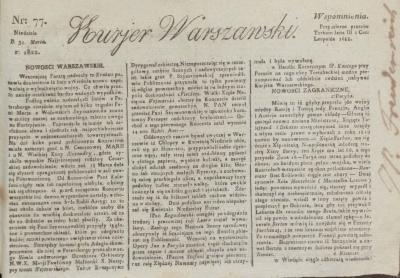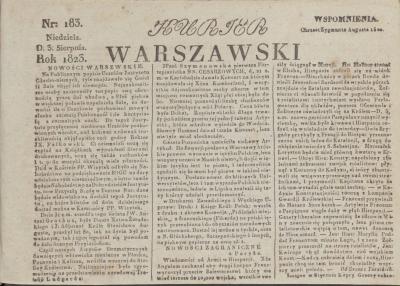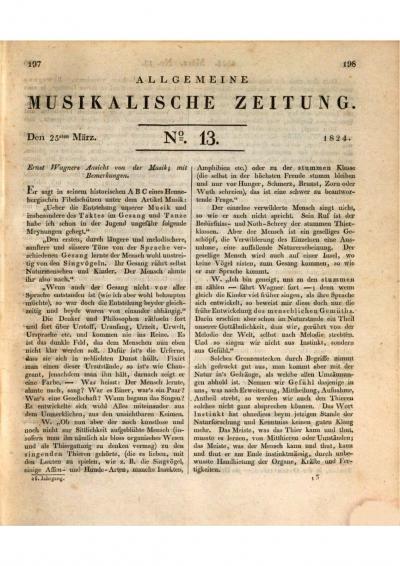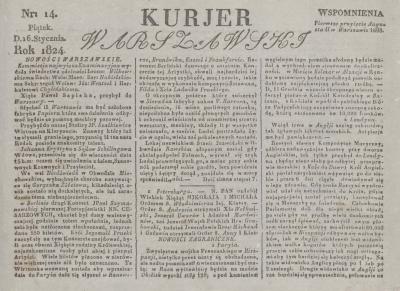Madame Szymanowska and Goethe – a burning love?

After Szymanowska left Weimar on 5 November 1823[69], she travelled to Halle and then to Dessau, where she gave a concert before the ducal family von Anhalt-Dessau. She then travelled to Berlin again, where she gave concerts on 10 December and on 7 January of the following year. In relation to the first concert that took place in the afternoon and for which entry tickets were sold, The Kurjer Warszawski reported that the Prussian King, accompanied by princes, select personalities and leading artists, had attended the performance. Szymanowska’s pace, rigour and her feeling when playing the pieces by Beethoven, Field and the Prussian Prince Louis Ferdinand were praised by a Berlin reviewer. The pianist had been asked, on her way to Paris, to also perform in Hannover, Braunschweig, Kassel and Frankfurt (PDF 6).[70] The concert on 7 January 1824 was held, as the Allgemeine musikalische Zeitung wrote, on the occasion of a “morning entertainment” at which a quintet for wind instruments and piano by Beethoven, a trio for piano, violin and cello by Prince Louis Ferdinand and a “Rondo alla Polacca” by Field were performed “not without applause from the numerous people present”.[71] During her stay in Berlin, Szymanowska corresponded with Chancellor von Müller whom she told about her future travel plans, through whom she sent greetings to Goethe and from whom she requested a letter of recommendation to be sent to Braunschweig. On 1 January, she met Ottilie von Goethe in Berlin.[72]
In actual fact, on her subsequent trip to Paris, Szymanowska did stop in the cities that had been flagged. On 26 January 1824, Goethe noted in his diary: “Letter from Madame Szymanowska from Frankfurt”[73] and on the same day reported to his daughter-in-law Ottilie: “My friend Szymanowska was warmly received in Braunschweig, flew through Hannover, arrived as quick as lightening in Frankfurt where Schlossers were accommodating to her …”[74] As the Kurjer Warszawski reported, after her concerts in Braunschweig and Hannover she received an invitation for a concert trip to London. In Kassel, she met the violinist and composer Ludwig Spohr, who was working there as a conductor and choirmaster and who, like many other famous musicians before him, wrote a “mystery round” composed for her and a dedication in her poetry and scrapbook album.[75]
In March and April 1824, she performed in Paris where she met Prince Radziwill, in London from May to June, in Milan in October, in Florence in November and in Rome, Naples and Venice in the run up to January 1825. From February to September 1825, she gave concerts again in London, then in Paris and Amsterdam until the end of the year. (Fig. 11) In the first half of 1826, she was in London and Paris and then returned to Warsaw. In January and February 1827, she gave farewell concerts in Warsaw and Vilnius, in March and April in Riga and St. Petersburg, before settling with her daughters Helena and Celina in St. Petersburg. In 1828, she embarked on another concert tour to Kiev, Warsaw, Moscow and St. Petersburg, which ended in March of that year.[76]
From that point on, she taught and socialised with a group of friends and acquaintances, which included famous poets and musicians, such as Mickiewicz, Alexander Puschkin, Michael Glinka and John Field. In July 1831, she died after falling victim to a cholera epidemic that had gripped the whole of Europe and Russia.[77] Her compositions kept her memory alive for several years. She has been listed in the leading European music lexica since her death, and still is today.[78] In 1836, the composer Robert Schumann wrote about Szymanowska and the etudes that she had written: “The name will be a wonderful memory for many. We often heard this virtuoso called the female field in which, if these etudes are anything to go by, shows that there is some truth in it. They are delicate blue wings that neither push down nor lift the weighing scale, and which nobody would wish to truly challenge. […] In creation and character, at any rate, we call her the most significant find that the musical world of womankind has delivered to date…”[79]
Axel Feuß, September 2021
[69] On the day of her departure, Goethe’s daughter-in-law Ottilie and the author Johanna Schopenhauer, who was the mother of the philosopher Arthur Schopenhauer and who was friends with Goethe, wrote entries in Szymanowska’s scrapbook and poetry albums (now in the Bibliothèque polonaise in Paris); compare Bischler 2017, see Literature, page 87.
[70] Nowosci Warszawskie, in: Kurjer Warszawski, No. 14, 16 January 1824, page 1, column 1 f. (see PDF 6), online resource: https://jbc.bj.uj.edu.pl/dlibra/publication/744609/edition/706449/content) – Compare also Kijas 2010 (see Literature), page 55 (incorrect there: 10 January)
[71] Berlin. Uebersicht des Januar, in: Allgemeine musikalische Zeitung, No. 7, Leipzig, 12 February 1824, column 107, online resource: https://www.digitale-sammlungen.de/de/view/bsb10527974_00069_u001?q=Szymanowska&page=4,5
[72] Bischler 2017 (see Literature), pages 92 f.
[73] 26. January 1824. Goethe: Tagebücher (see Note 28), page 171
[74] To Ottilie von Goethe. Weimar, Montag, den 26. Jenner 1824. Goethe: Briefe (see Note 32), page 32
[75] First published by Józef Mirski 1953 (see Literature). – Compare also Kijas 2010 (see Literature), page 56
[76] Directory of concert tours in Kijas 2010 (see Literature), page XIII-XV. – Kijas painstakingly evaluated letters and diaries from the Szymanowska family.
[77] “Notice. According to reliable news, the great piano virtuoso and gracious Ms Szymanowska has died of cholera in Petersburg.” (Allgemeine musikalische Zeitung, No. 35, Leipzig, 31/8/1831, column 584, online resource: https://www.digitale-sammlungen.de/de/view/bsb10527981_00331_u001?q=Szymanowska&page=8
[78] Verzeichnis der frühen Lexika bei Bischler 2017 (see Literature), pages 209 f. Lastly Irena Poniatowska: Szymanowska, Maria (Agata), in: Die Musik in Geschichte und Gegenwart (MGG), second edition, individual part, Volume 16, Kassel/Stuttgart 2006; MGG online 2016, https://www.mgg-online.com/article?id=mgg12647&v=1.0&rs=mgg12647 (subscription)
[79] 1836. Maria Szymanowska, 12 etudes. [Issue 1. 2.], in: Robert Schumann: Gesammelte Schriften über Musik und Musiker, second volume, Leipzig, 1854, pages 17 f., online resource: https://www.digitale-sammlungen.de/de/view/bsb10599478?q=Szymanowska&page=20,21
















